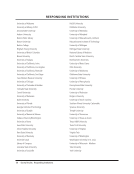SPEC Kit 335: Digital Image Collections and Services · 25
The Libraries has a digitization plan, which is focused on plans for content and processing. We have a DAM, but no
overarching plan.
We are in the beginning stages of trying to get a DAM plan in place, but do not have anything event drafted at present.
There have been many discussions about this to date, however.
We are in the process of creating overarching policies to compliment separate project specific policies.
We do not currently have a written DAM, though we have been following best practices where we can. We are currently
writing a program statement for DIOA, which includes strategic planning for digital preservation.
We have bits and pieces of a DAMP that covers things such as preservation/digitization standards/cataloging, etc. but
no overarching plan.
CATEGORIES OF DIGITAL IMAGES
2. Please indicate which categories of digital images your library holds. Check all that apply. N=80
Locally digitized analog images 78 98%
Commercial, licensed collections of digital images 69 86%
Locally created born-digital images 68 85%
Other category of digital image 20 25%
If you selected “Other category of digital image” above, please briefly describe the category. N=20
Analog images digitized by a vendor.
Blog collecting and archiving management, to include images captured with archived blogs.
Born-digital archival collections.
Born-digital collections purchased or acquired through gift to Special Collections.
Born-digital images created by other organizations or individuals and acquired by the University Libraries.
Born-digital images created remotely, in the field, by an anthropologist.
Community member contributions.
Externally digitized analog images and externally created born digital images from donors and partners.
Externally digitized and born-digital curated materials from partner holdings, donated digital images.
Gifts and donations from donors and from coordinated collaborations on collections with partner groups and
institutions.
Local resource, but digitization by vendor.
“Other” checked to reflect contributions to mass digitization work, Internet Archive, and Google.
Other non-institutional collections (e.g., historical societies).
The Libraries has a digitization plan, which is focused on plans for content and processing. We have a DAM, but no
overarching plan.
We are in the beginning stages of trying to get a DAM plan in place, but do not have anything event drafted at present.
There have been many discussions about this to date, however.
We are in the process of creating overarching policies to compliment separate project specific policies.
We do not currently have a written DAM, though we have been following best practices where we can. We are currently
writing a program statement for DIOA, which includes strategic planning for digital preservation.
We have bits and pieces of a DAMP that covers things such as preservation/digitization standards/cataloging, etc. but
no overarching plan.
CATEGORIES OF DIGITAL IMAGES
2. Please indicate which categories of digital images your library holds. Check all that apply. N=80
Locally digitized analog images 78 98%
Commercial, licensed collections of digital images 69 86%
Locally created born-digital images 68 85%
Other category of digital image 20 25%
If you selected “Other category of digital image” above, please briefly describe the category. N=20
Analog images digitized by a vendor.
Blog collecting and archiving management, to include images captured with archived blogs.
Born-digital archival collections.
Born-digital collections purchased or acquired through gift to Special Collections.
Born-digital images created by other organizations or individuals and acquired by the University Libraries.
Born-digital images created remotely, in the field, by an anthropologist.
Community member contributions.
Externally digitized analog images and externally created born digital images from donors and partners.
Externally digitized and born-digital curated materials from partner holdings, donated digital images.
Gifts and donations from donors and from coordinated collaborations on collections with partner groups and
institutions.
Local resource, but digitization by vendor.
“Other” checked to reflect contributions to mass digitization work, Internet Archive, and Google.
Other non-institutional collections (e.g., historical societies).


































































































































































































